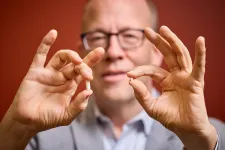(Press-News.org) Researchers at UCL and University of Ghana have successfully predicted whether children have anaemia using only a set of smartphone images.
The study, published in PLOS ONE, brought together researchers and clinicians at UCL Engineering, UCLH and Korle Bu Teaching Hospital, Ghana to investigate a new non-invasive diagnostic technique using smartphone photographs of the eye and face.
The advance could make anaemia screening more widely available for children in Ghana (and other low- and middle-income countries) where there are high rates of the condition due to iron deficiency, as the screening tool is much cheaper than existing options and delivers results in one sitting.
The paper builds on previous successful research undertaken by the same team exploring use of an app – neoSCB - to detect jaundice in newborn babies.
Anaemia is a condition causing a reduced concentration of haemoglobin in the blood, which means oxygen is not transported efficiently around the body.
It affects two billion people globally and can have a significant impact on developmental outcomes in children, increasing their susceptibility to infectious diseases and impairing their cognitive development.
The most common cause of anaemia globally is iron deficiency, but other conditions such as blood loss, malaria and sickle-cell disease also contribute.
First author, PhD candidate Thomas Wemyss (UCL Medical Physics & Biomedical Engineering) said: “Smartphones are globally popular, but research using smartphone imaging to diagnose diseases shows a general trend of experiencing difficulty when transferring results to different groups of people.
“We are excited to see these promising results in a group which is often underrepresented in research into smartphone diagnostics. An affordable and reliable technique to screen for anaemia using a smartphone could drive long-term improvements in quality of life for a large amount of people.”
Traditionally, diagnosis of anaemia requires blood samples to be taken, which can be costly for patients and healthcare systems. It can create inequalities related to the expense of travelling to hospital for a blood test. Often families need to make two trips, to have a blood sample taken and then to collect their results, due to samples being transported between the clinic and the laboratory for analysis.
In the 1980s a handheld device, the HemoCue, was developed to provide more immediate results, but this carries significant upfront and ongoing costs, as well as still needing a finger-prick blood sample.
The researchers knew that haemoglobin has a very characteristic colour due to the way it absorbs light, so aimed to develop a procedure to take smartphone photographs and use them to predict whether anaemia is present.
They analysed photos taken from 43 children aged under four who were recruited to take part in the study in 2018. The images were of three regions where minimal skin pigmentation occurs in the body (the white of the eye, the lower lip and the lower eyelid).
The team found that when these were evaluated together to predict blood haemoglobin concentration, they were able to successfully detect all cases of individuals with the most severe classification of anaemia, and to detect milder anaemia at rates which are likely to be clinically useful.
Principal investigator Dr Terence Leung (UCL Medical Physics & Biomedical Engineering) said: “Since 2018, we’ve been working with University of Ghana on affordable ways to improve healthcare using smartphones. Following our success in screening neonatal jaundice, we are so excited to see that the smartphone imaging technique can also apply to anaemia screening in young children and infants.”
Senior author Dr Judith Meek (UCLH) added: “Anaemia is a significant problem for infants, especially in low- and middle-income countries, and we hope this sort of technology will lead to earlier detection and treatment in the near future.”
The study was funded by the EPSRC via the UCL Global Challenges Research Fund and UCL Centre for Doctoral Training in Intelligent, Integrated Imaging in Healthcare.
END
Detecting anaemia earlier in children using a smartphone
2023-03-03
ELSE PRESS RELEASES FROM THIS DATE:
Israel: the origin of the world's grapevines
2023-03-03
A recent study on the genetic makeup of grapevine has revealed fascinating insights into its domestication and evolution. The study, published in the journal Science, suggests that the harsh climate during the Pleistocene era resulted in the fragmentation of wild ecotypes, which paved the way for the domestication of grapevine about 11,000 years ago in the Near East (Israel) and the Caucasus.
The research team sequenced the genomes of 3525 grapevine accessions (2503 V. vinifera (domesticated) and 1022 V. sylvestris (wild) accessions of grapevine, to identify the genetic changes that occurred during domestication and evolution of grapevine in Euro-Asia.
According to the study, ...
IPK researchers provide insights into grain number determination mechanism of barley
2023-03-03
Modifying inflorescences with higher grain capacity is vital for crop grain production. One recurring target is to select inflorescences with more branches or floral structures. Prominent examples include genes affecting floral identity or meristem determinacy, for which natural or induced variants profoundly change floral primordium number. Yet for temperate cereal crops, such as wheat and barley, excessive floral structures can result in a degeneration penalty due to the indeterminate nature of meristems. On the other hand, the manifestation of this reproductive potential can be accentuated by environmental ...
Pitt and UCI researchers receive grant to understand patient reactions to Alzheimer's disease diagnoses
2023-03-03
University of Pittsburgh and University of California, Irvine (UCI) researchers have received funding from the National Institute of Aging to advance understanding of real-world patient and family member reactions to biomarker-informed Alzheimer’s disease and related disorders diagnoses.
The grant, which is expected to total $3.5 million over up to five years, will enable researchers to better understand the experiences and potential psychological impact of receiving Alzheimer’s biomarker results. These findings will provide important information for supporting patients and their families and inform best practices in the rapidly evolving state-of-the-art diagnostic ...
Oncotarget | Unveiling the non-canonical functions of EZH2 in prostate cancer
2023-03-03
“In summary, both articles by Yi et al. emphasized the significance of non-canonical functions of EZH2 during PCa [prostate cancer] development [...]”
BUFFALO, NY- March 3, 2023 – A new editorial paper was published in Oncotarget's Volume 14 on February 11, 2023, entitled, “Unveiling the non-canonical functions of EZH2 in prostate cancer.”
Prostate cancer (PCa) is ranked as the second leading cause of cancer-related death among American men excluding skin cancer. ...
Adding antipsychotic med to antidepressant may help older adults with treatment-resistant depression
2023-03-03
For older adults with clinical depression that has not responded to standard treatments, adding the drug aripiprazole (brand name Abilify) to an antidepressant they’re already taking is more effective than switching from one antidepressant to another, according to a new multicenter study led by Washington University School of Medicine in St. Louis.
Aripiprazole originally was approved by the FDA in 2002 as a treatment for schizophrenia but also has been used in lower doses as an add-on treatment for clinical depression ...
American Foregut Society white paper recommends expanding endoscopic classification of esophogastric junction integrity beyond hill grade
2023-03-03
A new white paper by the American Foregut Society recommends expanding the classification of the esophagogastric junction (EGJ) to increase an assessment of the axial hiatal hernia length, hiatal hernia aperture diameter, and presence or absence of the flap value making it more comprehensive. The white paper is published in the December issue of Foregut, the only subscription journal focused exclusively on foregut disease linking medical, endoscopic, and surgical disciplines.
Gastrointestinal reflux disease ...
A good night’s sleep may make it easier to stick to exercise and diet goals, study found
2023-03-03
Research Highlights:
People who had higher scores for sleep health — based on regularity, satisfaction, alertness, timing, efficiency and duration — during a 12-month weight loss program were more likely to follow the caloric intake and exercise components of the program in comparison to peers who scored lower for sleep health.
People with better sleep health attended more of the program’s group sessions.
Embargoed until 10:15 a.m. CT/11:15 a.m. ET, Friday, March 3, 2023
DALLAS, March 3, 2023 — ...
Grant fuels project to highlight untold history across Appalachia
2023-03-03
From working with Appalachian communities to examining issues of displacement for refugees, two Virginia Tech faculty have made it their life and scholarly mission to recognize the people that society often overlooks.
Now a prestigious national foundation is giving them significant resources to tell the hidden historical stories of communities throughout Southwest Virginia, an opportunity to put their passion into action.
Emily Satterwhite and Katrina Powell received a $3 million grant from the Andrew W. Mellon Foundation for a three-year project to work with communities across the state’s Appalachia region to commemorate neglected histories.
Their project, Monuments ...
Augmenting the human body with a wearable robotic arm
2023-03-03
Washington, AAAS Annual Meeting. Imagine having a third arm – a robotic one – to assist you with daily living. Silvestro Micera from EPFL, Switzerland, is engineering the human nervous system to make this a possibility.
For decades, professor Silvestro Micera of EPFL has dedicated his research to helping people with sensory and motor deficits to re-gain independence and quality of life by developing wearable and implantable technologies. But this is changing, as he begins to explore what it means to augment the human body.
The neuroengineer has thus far avoided the subject of ...
Developing individualized, optimized brain injury rehabilitation
2023-03-03
More than 500,000 people in the United States undergo rehabilitation following a stroke or brain injury every year. Movement impairments following a stroke are a major cause of adult disability in the United States, and routine treatments are not currently optimized for individual patient needs.
University of Oklahoma biomedical engineer Yuan Yang, Ph.D., has received a Faculty Early Career Development Award, known as a CAREER award, from the National Science Foundation to advance the scientific study of brain functional changes after a stroke and pioneer a tailored rehabilitation strategy that fits individual needs.
“The way a stroke victim’s brain adapts to the ...




